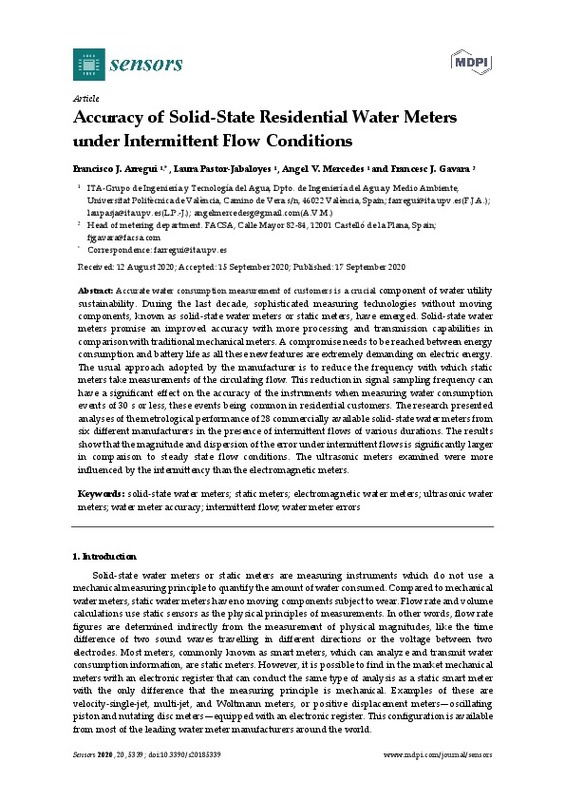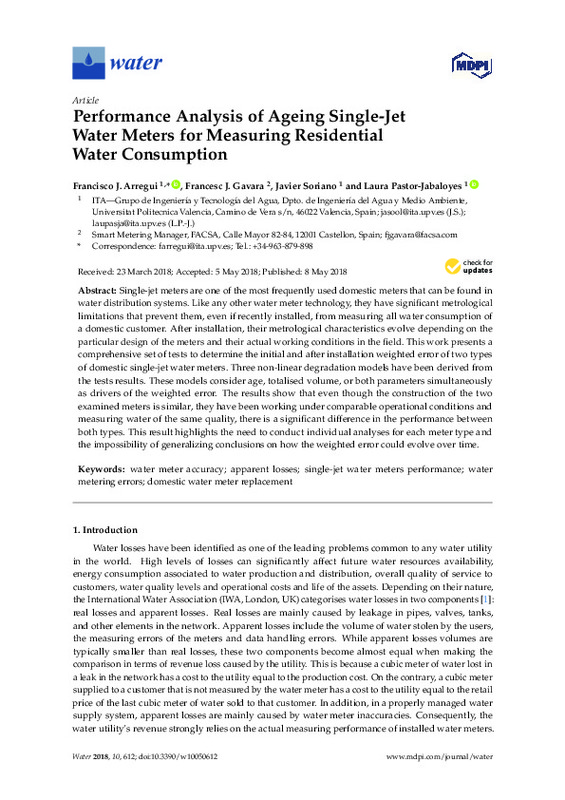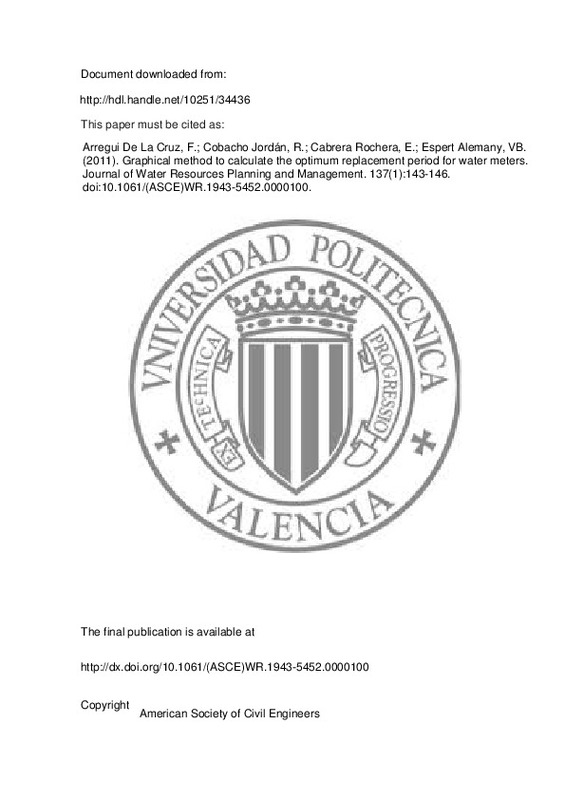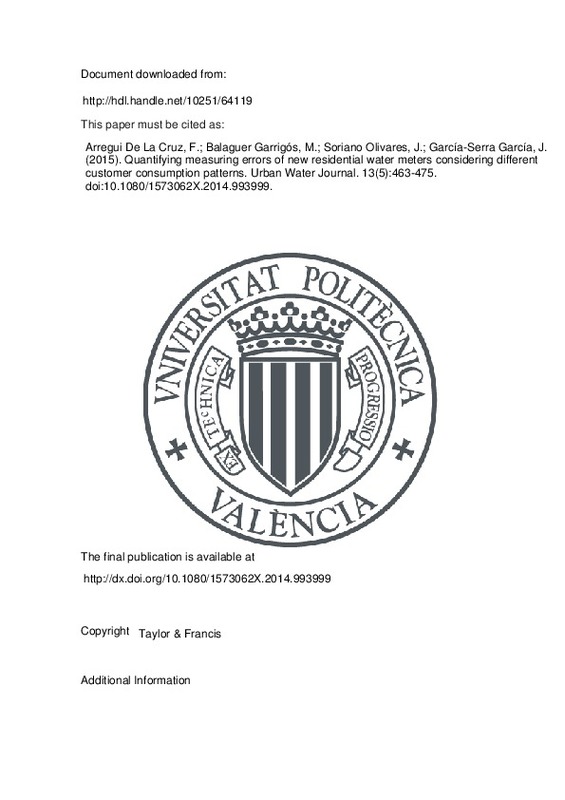JavaScript is disabled for your browser. Some features of this site may not work without it.
Buscar en RiuNet
Listar
Mi cuenta
Estadísticas
Ayuda RiuNet
Admin. UPV
Accuracy of Solid-State Residential Water Meters under Intermittent Flow Conditions
Mostrar el registro sencillo del ítem
Ficheros en el ítem
| dc.contributor.author | Arregui de la Cruz, Francisco
|
es_ES |
| dc.contributor.author | Pastor-Jabaloyes, Laura
|
es_ES |
| dc.contributor.author | Mercedes, Angel V.
|
es_ES |
| dc.contributor.author | Gavara-Tortes, Francesc Josep
|
es_ES |
| dc.date.accessioned | 2021-06-12T03:33:36Z | |
| dc.date.available | 2021-06-12T03:33:36Z | |
| dc.date.issued | 2020-09 | es_ES |
| dc.identifier.uri | http://hdl.handle.net/10251/167862 | |
| dc.description.abstract | [EN] Accurate water consumption measurement of customers is a crucial component of water utility sustainability. During the last decade, sophisticated measuring technologies without moving components, known as solid-state water meters or static meters, have emerged. Solid-state water meters promise an improved accuracy with more processing and transmission capabilities in comparison with traditional mechanical meters. A compromise needs to be reached between energy consumption and battery life as all these new features are extremely demanding on electric energy. The usual approach adopted by the manufacturer is to reduce the frequency with which static meters take measurements of the circulating flow. This reduction in signal sampling frequency can have a significant effect on the accuracy of the instruments when measuring water consumption events of 30 s or less, these events being common in residential customers. The research presented analyses of the metrological performance of 28 commercially available solid-state water meters from six different manufacturers in the presence of intermittent flows of various durations. The results show that the magnitude and dispersion of the error under intermittent flows is significantly larger in comparison to steady state flow conditions. The ultrasonic meters examined were more influenced by the intermittency than the electromagnetic meters. | es_ES |
| dc.description.sponsorship | The work was partially funded by the Catedra UPV-FACSA-FOVASA de Agua, Residuos y Economia Circular. The authors are very grateful for the funding support. The authors would like to acknowledge the material and assistance received from FACSA during the development of the research. | es_ES |
| dc.language | Inglés | es_ES |
| dc.publisher | MDPI AG | es_ES |
| dc.relation.ispartof | Sensors | es_ES |
| dc.rights | Reconocimiento (by) | es_ES |
| dc.subject | Solid-State water meters | es_ES |
| dc.subject | Static meters | es_ES |
| dc.subject | Electromagnetic water meters | es_ES |
| dc.subject | Ultrasonic water meters | es_ES |
| dc.subject | Water meter accuracy | es_ES |
| dc.subject | Intermittent flow | es_ES |
| dc.subject | Water meter errors | es_ES |
| dc.subject.classification | INGENIERIA HIDRAULICA | es_ES |
| dc.title | Accuracy of Solid-State Residential Water Meters under Intermittent Flow Conditions | es_ES |
| dc.type | Artículo | es_ES |
| dc.identifier.doi | 10.3390/s20185339 | es_ES |
| dc.rights.accessRights | Abierto | es_ES |
| dc.contributor.affiliation | Universitat Politècnica de València. Departamento de Ingeniería Hidráulica y Medio Ambiente - Departament d'Enginyeria Hidràulica i Medi Ambient | es_ES |
| dc.description.bibliographicCitation | Arregui De La Cruz, F.; Pastor-Jabaloyes, L.; Mercedes, AV.; Gavara-Tortes, FJ. (2020). Accuracy of Solid-State Residential Water Meters under Intermittent Flow Conditions. Sensors. 20(18):1-28. https://doi.org/10.3390/s20185339 | es_ES |
| dc.description.accrualMethod | S | es_ES |
| dc.relation.publisherversion | https://doi.org/10.3390/s20185339 | es_ES |
| dc.description.upvformatpinicio | 1 | es_ES |
| dc.description.upvformatpfin | 28 | es_ES |
| dc.type.version | info:eu-repo/semantics/publishedVersion | es_ES |
| dc.description.volume | 20 | es_ES |
| dc.description.issue | 18 | es_ES |
| dc.identifier.eissn | 1424-8220 | es_ES |
| dc.identifier.pmid | 32957688 | es_ES |
| dc.identifier.pmcid | PMC7570974 | es_ES |
| dc.relation.pasarela | S\418071 | es_ES |
| dc.contributor.funder | Cátedra FACSA-FOVASA de Agua, Residuos y Economía Circular, Universitat Politècnica de València | es_ES |
| dc.description.references | Szilveszter, S., Beltran, R., & Fuentes, A. (2015). Performance analysis of the domestic water meter park in water supply network of Ibarra, Ecuador. Urban Water Journal, 14(1), 85-96. doi:10.1080/1573062x.2015.1057181 | es_ES |
| dc.description.references | Arregui, F. ., Cabrera, E., Cobacho, R., & García-Serra, J. (2006). Reducing Apparent Losses Caused By Meters Inaccuracies. Water Practice and Technology, 1(4). doi:10.2166/wpt.2006.093 | es_ES |
| dc.description.references | Richards, G. L., Johnson, M. C., & Barfuss, S. L. (2010). Apparent losses caused by water meter inaccuracies at ultralow flows. Journal - American Water Works Association, 102(5), 123-132. doi:10.1002/j.1551-8833.2010.tb10115.x | es_ES |
| dc.description.references | Mbabazi, D., Banadda, N., Kiggundu, N., Mutikanga, H., & Babu, M. (2015). Determination of domestic water meter accuracy degradation rates in Uganda. Journal of Water Supply: Research and Technology-Aqua, 64(4), 486-492. doi:10.2166/aqua.2015.083 | es_ES |
| dc.description.references | Mutikanga, H., Sharma, S., & Vairavamoorthy, K. (2011). Investigating water meter performance in developing countries: A case study of Kampala, Uganda. Water SA, 37(4). doi:10.4314/wsa.v37i4.18 | es_ES |
| dc.description.references | Stoker, D. M., Barfuss, S. L., & Johnson, M. C. (2012). Flow measurement accuracies of in-service residential water meters. Journal - American Water Works Association, 104(12), E637-E642. doi:10.5942/jawwa.2012.104.0145 | es_ES |
| dc.description.references | Arregui, F., Gavara, F., Soriano, J., & Pastor-Jabaloyes, L. (2018). Performance Analysis of Ageing Single-Jet Water Meters for Measuring Residential Water Consumption. Water, 10(5), 612. doi:10.3390/w10050612 | es_ES |
| dc.description.references | ISO - ISO 4064-1:2014 - Water Meters for Cold Potable Water and Hot Water—Part 1: Metrological and Technical Requirements https://www.iso.org/standard/55371.html | es_ES |
| dc.description.references | Buck, B. S., Johnson, M. C., & Barfuss, S. L. (2012). Effects of particulates on water meter accuracy through expected life. Journal - American Water Works Association, 104(4), E231-E242. doi:10.5942/jawwa.2012.104.0054 | es_ES |
| dc.description.references | Blokker, E. J. M., Vreeburg, J. H. G., & van Dijk, J. C. (2010). Simulating Residential Water Demand with a Stochastic End-Use Model. Journal of Water Resources Planning and Management, 136(1), 19-26. doi:10.1061/(asce)wr.1943-5452.0000002 | es_ES |
| dc.description.references | ISO - ISO 4064-2:2014 - Water Meters for Cold Potable Water and Hot Water—Part 2: Test Methods https://www.iso.org/standard/55383.html | es_ES |
| dc.description.references | Chadwick, J. R., Barfuss, S. L., & Johnson, M. C. (2018). Accuracy of residential water meters in response to short, intermittent flows. AWWA Water Science, 1(1). doi:10.1002/aws2.1010 | es_ES |
| dc.description.references | R: A Language and Environment for Statistical Computing 2019 https://www.R-project.org/ | es_ES |
| dc.description.references | OIML—OIML R 49-1:2013—Water Meters for Cold Potable Water and Hot Water—Part 1: Metrological and Technical Requirements https://www.oiml.org/en/files/pdf_r/r049-1-e13.pdf | es_ES |
| dc.description.references | Buchberger, S. G., & Wu, L. (1995). Model for Instantaneous Residential Water Demands. Journal of Hydraulic Engineering, 121(3), 232-246. doi:10.1061/(asce)0733-9429(1995)121:3(232) | es_ES |
| dc.description.references | Alvisi, S. (2003). Water Resources Management, 17(3), 197-222. doi:10.1023/a:1024100518186 | es_ES |
| dc.description.references | Alcocer-Yamanaka, V. H., Tzatchkov, V. G., & Arreguin-Cortes, F. I. (2012). Modeling of Drinking Water Distribution Networks Using Stochastic Demand. Water Resources Management, 26(7), 1779-1792. doi:10.1007/s11269-012-9979-2 | es_ES |











